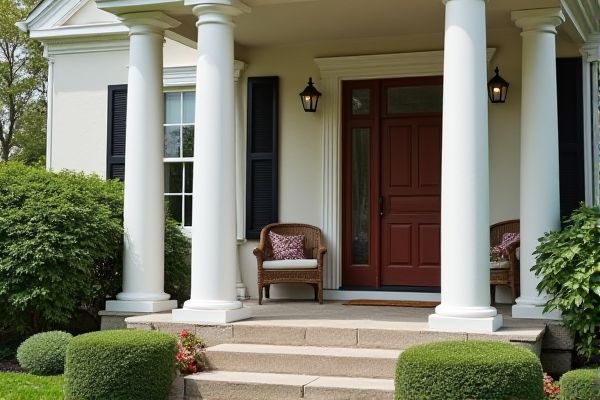
Porch columns and pillars both provide structural support but differ in style and construction, with columns typically being round and classical, while pillars are often square or rectangular and more robust. Explore the rest of this article to understand which option best suits Your architectural needs and aesthetic preferences.
Table of Comparison
| Feature | Porch Columns | Porch Pillars |
|---|---|---|
| Definition | Vertical supports typically round, decorative, and slender. | Sturdy, often square or rectangular structural supports. |
| Material | Wood, fiberglass, aluminum. | Brick, stone, concrete, wood. |
| Function | Primarily aesthetic with light structural support. | Mainly load-bearing and structural support. |
| Style | Classical, Victorian, Colonial. | Rustic, modern, traditional. |
| Size | Typically slimmer and taller. | Bulkier and shorter in comparison. |
| Installation | Easier and lighter to install. | Requires solid foundation and professional installation. |
| Durability | Moderate, depends on material. | High, built to last and bear weight. |
Introduction to Porch Columns and Pillars
Porch columns and pillars serve as essential structural and decorative elements that support the porch roof and enhance curb appeal. Columns are typically round and more refined, often featuring classical orders such as Doric or Ionic, while pillars tend to be square or rectangular, offering a more robust and solid appearance. Understanding the distinctions between porch columns and pillars helps homeowners choose the ideal architectural style for their home's exterior design.
Key Differences Between Columns and Pillars
Porch columns are typically structural elements that support the roof or upper structure, often round and hollow, designed to bear weight and provide stability. Pillars, on the other hand, can be either structural or decorative and are usually solid, with varied shapes such as square or rectangular, emphasizing aesthetic appeal alongside functionality. Columns often feature classical architectural details like fluting and capitals, whereas pillars prioritize mass and form, making them key differences in both design and structural use.
Structural Roles: Columns vs Pillars
Porch columns primarily serve as vertical structural supports designed to bear and transfer the weight of the roof or upper structures directly to the foundation, ensuring stability and preventing collapse. Pillars, while also vertical supports, can have a dual role: structural load-bearing and decorative or symbolic purposes, often found in architectural features where aesthetics are emphasized alongside function. The key difference lies in columns being engineered explicitly for load distribution, whereas pillars may or may not support structural loads depending on design intent.
Material Options for Columns and Pillars
Porch columns and pillars come in a variety of material options that impact durability, aesthetics, and maintenance. Common materials include wood, which offers a classic and customizable look; fiberglass, known for its resistance to weather and low upkeep; and stone or brick, providing a sturdy, timeless appearance. Your choice should balance the architectural style of your home with the environmental conditions to ensure lasting performance.
Design Styles and Aesthetic Impact
Porch columns often feature classical designs such as Doric, Ionic, and Corinthian, lending a refined and formal aesthetic to traditional and Colonial-style homes. Pillars, typically more robust and square or rectangular in shape, complement Craftsman and modern architectural styles with a sturdy, geometric presence. The choice between columns and pillars significantly influences the porch's visual appeal, enhancing either elegance or contemporary boldness in outdoor living spaces.
Durability and Maintenance Considerations
Porch columns made from materials like fiberglass and aluminum offer superior durability and low maintenance, resisting rot, insects, and weather damage compared to traditional wood pillars. Wood pillars, while aesthetically pleasing, require regular sealing, painting, and inspections to prevent decay and pest infestation. Composite materials blend the visual appeal of wood with enhanced longevity and reduced upkeep, making them a practical choice for long-term maintenance.
Cost Comparison: Columns Versus Pillars
Porch columns typically cost between $200 and $1,500 per piece depending on material such as wood, fiberglass, or PVC, making them a budget-friendly option for most homeowners. Pillars, often constructed from stone, brick, or concrete, can range from $1,000 to over $10,000 due to their heavier, more durable design and labor-intensive installation. Cost factors also include size, finish, and structural requirements, with columns generally offering greater affordability and ease of replacement compared to the higher investment and permanence of pillars.
Installation Process for Each Option
Porch columns typically require precise measurements and a sturdy foundation to ensure proper alignment and support during installation. Pillars, often heavier and more structural, may need deeper footings or reinforced bases to handle greater loads and provide stability. Choosing the right option depends on your porch design and structural needs, as installation complexity varies between lightweight columns and robust pillars.
Best Applications: When to Choose Columns or Pillars
Porch columns are best suited for traditional and classical architectural styles, providing structural support and aesthetic appeal in evenly spaced intervals. Pillars, often more massive and ornamental, work well for grand entrances or free-standing features where a bold, dramatic statement is desired. Your choice depends on whether you need functional load-bearing support with elegant design (columns) or a strong, decorative element (pillars) to enhance the porch's visual impact.
Conclusion: Making the Right Choice for Your Porch
Porch columns and pillars serve structural and aesthetic purposes but differ in design and materials, with columns typically featuring classical shapes like Doric or Ionic and pillars often being square or rectangular and more robust. Your choice depends on the architectural style of your home, budget, and desired visual impact, balancing durability and elegance. Selecting the right support enhances curb appeal and ensures long-lasting stability for your porch.
 homyna.com
homyna.com